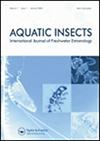对科西嘉石蝇鼓动信号知识的第二份贡献(褶翅目:石蝇科、石蝇目和石蝇科)
IF 0.6
4区 农林科学
Q4 ENTOMOLOGY
引用次数: 0
摘要
在这篇关于科西嘉石蝇鼓动信号的第二篇文章中,描述了三个物种的完整振动二重奏。科西嘉石蝇(Protonemura corsicana)(莫顿,1930 年)表现出典型的信号模式。本文章由计算机程序翻译,如有差异,请以英文原文为准。
Second contribution to the knowledge of drumming signals of stoneflies from Corsica (Plecoptera: Nemouridae, Leuctridae and Perlodidae)
In this second article on drumming signals of Corsican stoneflies, the complete vibrational duets of three species are described. Protonemura corsicana (Morton, 1930) shows the typical signal patte...
求助全文
通过发布文献求助,成功后即可免费获取论文全文。
去求助
来源期刊

Aquatic Insects
生物-昆虫学
CiteScore
2.00
自引率
25.00%
发文量
27
审稿时长
>12 weeks
期刊介绍:
Aquatic Insects is an international journal publishing original research on the systematics, biology, and ecology of aquatic and semi-aquatic insects.
The subject of the research is aquatic and semi-aquatic insects, comprising taxa of four primary orders, the Ephemeroptera, Odonata, Plecoptera, and Trichoptera but also aquatic and semi-aquatic families of Hemiptera, Coleoptera, and Diptera, as well as specific representatives of Hymenoptera , Lepidoptera, Mecoptera, Megaloptera , and Neuroptera that occur in lotic and lentic habitats during part of their life cycle. Studies on other aquatic Hexapoda (i.e., Collembola) will be only accepted if space permits. Papers on other aquatic Arthropoda (e.g., Crustacea) will not be considered, except for those closely related to aquatic and semi-aquatic insects (e.g., water mites as insect parasites).
The topic of the research may include a wide range of biological fields. Taxonomic revisions and descriptions of individual species will be accepted especially if additional information is included on habitat preferences, species co-existing, behavior, phenology, collecting methods, etc., that are of general interest to an international readership. Descriptions based on single specimens are discouraged.
Detailed studies on morphology, physiology, behavior, and phenology of aquatic insects in all stadia of their life cycle are welcome as well as the papers with molecular and phylogenetic analyses, especially if they discuss evolutionary processes of the biological, ecological, and faunistic formation of the group.
 求助内容:
求助内容: 应助结果提醒方式:
应助结果提醒方式:


